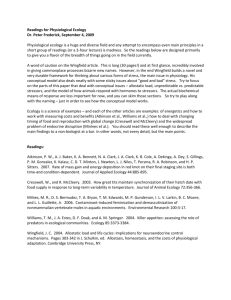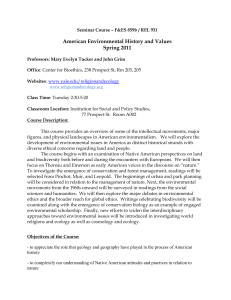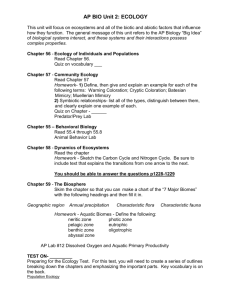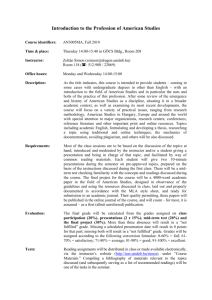Freshwater Ecology, or Limnology (Biol 053)
advertisement
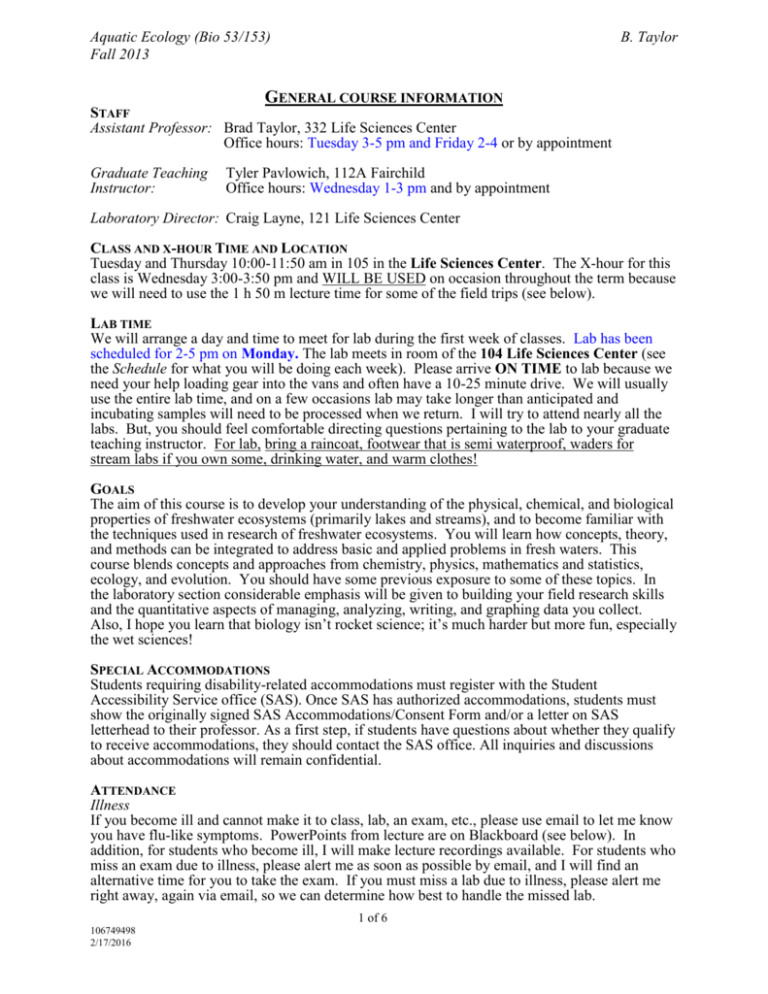
Aquatic Ecology (Bio 53/153) Fall 2013 B. Taylor GENERAL COURSE INFORMATION STAFF Assistant Professor: Brad Taylor, 332 Life Sciences Center Office hours: Tuesday 3-5 pm and Friday 2-4 or by appointment Graduate Teaching Instructor: Tyler Pavlowich, 112A Fairchild Office hours: Wednesday 1-3 pm and by appointment Laboratory Director: Craig Layne, 121 Life Sciences Center CLASS AND X-HOUR TIME AND LOCATION Tuesday and Thursday 10:00-11:50 am in 105 in the Life Sciences Center. The X-hour for this class is Wednesday 3:00-3:50 pm and WILL BE USED on occasion throughout the term because we will need to use the 1 h 50 m lecture time for some of the field trips (see below). LAB TIME We will arrange a day and time to meet for lab during the first week of classes. Lab has been scheduled for 2-5 pm on Monday. The lab meets in room of the 104 Life Sciences Center (see the Schedule for what you will be doing each week). Please arrive ON TIME to lab because we need your help loading gear into the vans and often have a 10-25 minute drive. We will usually use the entire lab time, and on a few occasions lab may take longer than anticipated and incubating samples will need to be processed when we return. I will try to attend nearly all the labs. But, you should feel comfortable directing questions pertaining to the lab to your graduate teaching instructor. For lab, bring a raincoat, footwear that is semi waterproof, waders for stream labs if you own some, drinking water, and warm clothes! GOALS The aim of this course is to develop your understanding of the physical, chemical, and biological properties of freshwater ecosystems (primarily lakes and streams), and to become familiar with the techniques used in research of freshwater ecosystems. You will learn how concepts, theory, and methods can be integrated to address basic and applied problems in fresh waters. This course blends concepts and approaches from chemistry, physics, mathematics and statistics, ecology, and evolution. You should have some previous exposure to some of these topics. In the laboratory section considerable emphasis will be given to building your field research skills and the quantitative aspects of managing, analyzing, writing, and graphing data you collect. Also, I hope you learn that biology isn’t rocket science; it’s much harder but more fun, especially the wet sciences! SPECIAL ACCOMMODATIONS Students requiring disability-related accommodations must register with the Student Accessibility Service office (SAS). Once SAS has authorized accommodations, students must show the originally signed SAS Accommodations/Consent Form and/or a letter on SAS letterhead to their professor. As a first step, if students have questions about whether they qualify to receive accommodations, they should contact the SAS office. All inquiries and discussions about accommodations will remain confidential. ATTENDANCE Illness If you become ill and cannot make it to class, lab, an exam, etc., please use email to let me know you have flu-like symptoms. PowerPoints from lecture are on Blackboard (see below). In addition, for students who become ill, I will make lecture recordings available. For students who miss an exam due to illness, please alert me as soon as possible by email, and I will find an alternative time for you to take the exam. If you must miss a lab due to illness, please alert me right away, again via email, so we can determine how best to handle the missed lab. 1 of 6 106749498 2/17/2016 Aquatic Ecology (Bio 53/153) Fall 2013 B. Taylor Religious Observances Some students may wish to take part in religious observances that occur during this academic term. If you have a religious observance that conflicts with your participation in the course, please meet with me before the end of the second week of the term to discuss appropriate accommodations. NOTE REGARDING USE OF MATERIALS POSTED ON BLACKBOARD ALL materials on our Blackboard site, including the recorded lectures, may not be posted on another website, broadcast, or distributed in electronic or print form to anyone else. Redistributing this material violates fair use, copyright, and privacy rights of the instructors and your fellow classmates. Thank you for understanding! TEXTBOOK I highly recommend Freshwater Ecology by W. Dodds and M. Whiles. This book is neither the magnum opus of freshwater ecology nor the das capital, but it is readable, current, and transportable compared to R. Wetzel’s Limnology book. Dodd’s book also covers streams, lakes, and wetlands. Copies of Limnology by Wetzel, Stream Ecology by J. D. Allan and M.M. Castillo, and two excellent books on methods: Methods in Stream Ecology and Limnological Analyses are on 4 hour reserve in Dana Library. JOURNAL ARTICLES The required readings for this course are from the primary literature (journal articles). For each lecture and some of the labs journal articles will be assigned (see Schedule). You can find these articles in the library, online using Web of Science (type web of science into the library catalog search box), and on Blackboard. Locating the journals and articles is a good way to get exposed to the freshwater ecology literature and find information or ideas for your independent projects, so I encourage you to read other articles that are cited in the required readings. I will be lecturing briefly on the concepts of the assigned articles and we will discuss them in depth during portions of class. Please do the readings ahead of time so you can contribute to the discussion. 10% of your grade will be based on your contribution to the class discussion of the papers. Also, please read the handout on Blackboard titled, A guide to critical thinking and evaluation of scientific literature. GOALS OF THE LABORATORY 1. Learn basic limnological field and lab methods. 2. Apply these methods to test hypotheses that you develop. 3. Understand the patterns and relationships between physical, chemical, and biological properties in aquatic ecosystems. Please map out well ahead of time when things are due and start early on them. I have tried to space things out as evenly as possible, but some tight scheduling is inevitable. The first few labs will be devoted to teaching you general concepts and methods relevant to aquatic ecosystems. We may use some out of class time to analyze and process some samples, such as chlorophyll that need to extract for 6-12 h before being analyzed. The remaining weeks of lab are set aside for you to use toward your independent project(s). However, you will need to get started on your project before that time. POSSIBLE FIELD TRIPS Weekend Field Trip (TBD) We will use a weekend field trip to learn more about streams and rivers. We will provide lodging, transport, meals, and scientific entertainment! 2 of 6 106749498 2/17/2016 Aquatic Ecology (Bio 53/153) Fall 2013 B. Taylor Hanover Wastewater Treatment Facility Meet Sister Sludge. During a lecture period we will visit the Hanover wastewater treatment facility for a hands-on tour (bring your gloves!). Fish Hatchery I am trying to schedule a visit to a local fish hatchery to learn about the complex and contentious role of supplementation programs in wildlife management for recreation and for restoring threatened/endangered species. COURSEWORK AND GRADING Exam questions will cover material covered in the lectures, labs, articles, and textbook. Journal article discussion Midterm exam (16 Oct) Final exam (25 Nov. 3 PM) Four 2-3 page lab write-ups¥ Independent project* (25 Nov.) 10% 20% 20% 20% 30% ¥Data analysis write-ups involve graphing, statistically analysis, calculations, and interpreting data we collect in lab. Write-ups should be no more than one or two pages of double-spaced text plus graphs, analyses, and calculations for each of the three write-ups. The goal of these is to learn concepts by working with real data from start to finish. Many of the approaches and techniques are the same ones used by professionals in the field, so you will learn a unique set of skills that you can take with you beyond this class. *There is one required paper. You will receive more detailed information about the structure of the paper later in the course. The paper is based on an independent research project designed by you and other members of the class (entire class or groups of 2-3 people). The paper will help you integrate material learned in lectures and labs to analyze, interpret, and synthesize your own field data of your choice! We will discuss some ideas for projects during the x-hour of the second week of classes, but you can start thinking now about what question might be exciting to explore. The length of the paper should be ~15-20 pages double spaced, including all the text, tables, figures, and 10-15 citations to journal articles or books that you have read and used as sources. Please read the handout entitled Hints for how to write scientific papers. Please plan ahead and do not turn papers in late, as you will lose one whole letter grade for each day it is late. Producing a product like this from a class project would be great for everyone and an important item to add to your resume – something to aim for in the design and data collection. In other words, aim for lots of replicates and maybe consider teaming up with another group to test two hypotheses or combine an observational and experimental approach to a question. There are no assigned labs during the later lab sections. This time is set aside for you to work on your independent projects. The graduate teaching instructor and I are available to help you during this time. Please give us some notice if you plan to work on your project and would like help so we can plan to be in the building. ACADEMIC HONESTY Academic honesty is essential. The following is quoted directly from the Dartmouth College Student Handbook: "Students who submit work that is not their own or who commit other acts of academic dishonesty forfeit the opportunity to continue at Dartmouth." The complete text of the Academic Honor Principle is in the Student Handbook or at (http://www.dartmouth.edu/~deancoll/documents/handbook/conduct/standards/honor.html). Please read the Honor Principle carefully; you are responsible for knowing and understanding the Honor Principle, and adhering to its letter and spirit. Any violations of the Honor Principle in this course must be referred to the Committee on Standards and can result in your suspension for multiple terms, or, in the most extreme cases, separation from the College. 3 of 6 106749498 2/17/2016 Aquatic Ecology (Bio 53/153) Fall 2013 B. Taylor SCHEDULE Below is an outline of topics that will be covered in class, in the order in which we will cover them. These topics may take longer than one class to complete. Unless I instruct you otherwise, assume that we will be getting to the next lecture topic the following class day and please do the readings ahead of time. Some of the readings may change if a new and exciting one is published during the quarter, or if you point one out to me. DAY, DATE Tu, 17 Sep. TOPIC Lecture: Introduction; Why study fresh waters? Th, 19 Sep. Lecture: Water movement, light, and heat in lakes Week 1 Tu, 24 Sep. NO LAB Lecture: Climate effects on stratification & lake process W, 25 Sep. X-hour Lecture: Physiography of lakes and streams Th, 26 Sep. Meet in 104 *Week 2 LAB: Lake vertical zonation Lecture: Hydrology Tu, 1 Oct. W, 2 Oct. Th, 3 Oct. *Week 3 X-hour (discuss project ideas) Lecture: Nutrient cycling and eutrophication Readings: Winder, M. and D. E. Schindler. 2004. Climate change uncouples trophic interactions in an aquatic ecosystem. Ecology 85: 2100-2106. Verburg P, Hecky RE, Kling H. 2003. Ecological consequences of a century of warming in Lake Tanganyika. Science 301: 505-507. Readings: Kratz T.K., Webster K.E., Bowser C.J., Magnuson J.J., Benson B.J. 1997. The influence of landscape position on lakes in northern Wisconsin. Freshwater Biology 37: 209-217. Vannote RL, Minshall GW, Cummins KW, Sedell JR, Cushing CE. 1980. The river continuum concept. Canadian Journal of Fisheries and Aquatic Sciences 37: 130-137. Process samples from week 2 lake sampling lab Readings: Poff, N. L., J. D. Allan, M. B. Bain, J. R. Karr, K. L. Prestegaard, B. D. Richter, R. E. Sparks, and J. C. Stromberg. 1997. The natural flow regime. Bioscience 47:769-784. Lytle, D. A., M. T. Bogan, and D. S. Finn. 2008. Evolution of aquatic insect behaviours across a gradient of disturbance predictability. Proceedings of the Royal Society B-Biological Sciences 275:453-462. Readings: Merz, J. E. and P. B. Moyle. 2006. Salmon, wildlife, and wine: Marine-derived nutrients in human-dominated ecosystems of central California. Ecological Applications 16:999-1009. Elser, J. J., T. Andersen, J. S. Baron, A. K. Bergstrom, M. Jansson, M. Kyle, K. R. Nydick, L. Steger, and D. O. Hessen. 2009. Shifts in Lake N:P Stoichiometry and Nutrient Limitation Driven by Atmospheric Nitrogen Deposition. Science 326:835-837. Vonlanthen P, Bittner D, Hudson AG, Young KA, Muller R, LundsgaardHansen B, Roy D, Di Piazza S, Largiader CR, Seehausen O. 2012. Eutrophication causes speciation reversal in whitefish adaptive radiations. Nature 482: 357-U1500. LAB: Setup top-down versus bottom-up control of algae experiment in Storrs Pond M 7 Oct. Tu, 8 ASSIGNMENT Readings: Vorosmarty, C. J., P. B. McIntyre, M. O. Gessner, D. Dudgeon, A. Prusevich, P. Green, S. Glidden, S. E. Bunn, C. A. Sullivan, C. R. Liermann, and P. M. Davies. 2010. Global threats to human water security and river biodiversity. Nature 468:334-334. Readings: Seehausen, O., J. J. M. vanAlphen, and F. Witte. 1997. Cichlid fish diversity threatened by eutrophication that curbs sexual selection. Science 277:18081811. Kling, G. W. 1987. Seasonal mixing and catastrophic degassing in tropical lakes, Cameroon, West Africa. Science 237:1022-1024. Field trip to the Lake vertical zonation lab write-up due via Blackboard as one WORD file by 9 pm Meet in the classroom and then proceed together to the vans parked on the 4 of 6 106749498 2/17/2016 Aquatic Ecology (Bio 53/153) Fall 2013 Oct. Hanover Wastewater Treatment Plant W, 9 Oct. Lecture: Dissolved oxygen, inorganic carbon, and pH Th, 10 Oct. Lecture: Primary producers and productivity *Week 4 LAB: Sample top-down versus bottom-up control of algae experiment Lecture: Detritus, fungi, and bacteria Tu, 15 Oct. W, 16 Oct. Th, 17 Oct. Lecture: Mid-term exam *Week 5 LAB: Rapid biological assessment of stream water quality M, 21 Oct. Tu, 22 Oct. W, 23 Oct. Th, 24 Oct. *Week 6 M, 28 Oct. Tu, 29 Oct. Th, 31 Oct. *Week 7 Lecture: Zooplankton B. Taylor north side of the LSC at 10:00. Readings: Correll D.L. 1999. The Role of Phosphorus in the Eutrophication of Receiving Waters: A Review. Journal of Environmental Quality 27: 261266. Readings: Likens, G. E., C. T. Driscoll, and D. C. Buso. 1996. Long-term effects of acid rain: Response and recovery of a forest ecosystem. Science 272:244-246. Caraco N, Cole J, Findlay S, Wigand C. 2006. Vascular plants as engineers of oxygen in aquatic systems. Bioscience 56: 219-225. Readings: Hutchinson, G. E. 1961. The paradox of the plankton. American Naturalist 95:137-146. Kilroy C, Bothwell ML. 2012. Didymosphenia geminata growth rates and bloom formation in relation to ambient dissolved phosphorus concentration. Freshwater Biology: 1-13. Independent Project Proposal DUE by 9 pm Readings: Wallace, J. B., S. L. Eggert, J. L. Meyer, and J. R. Webster. 1997. Multiple trophic levels of a forest stream linked to terrestrial litter inputs. Science 277:102-104. Pace, M. L., J. J. Cole, S. R. Carpenter, J. F. Kitchell, J. R. Hodgson, M. C. Van de Bogert, D. L. Bade, E. S. Kritzberg, and D. Bastviken. 2004. Wholelake carbon-13 additions reveal terrestrial support of aquatic food webs. Nature 427:240-243. Readings: Hairston, N. G., Jr., W. Lampert, C. E. Caceres, C. L. Holtmeier, L. J. Weider, U. Gaedke, J. M. Fischer, J. A. Fox, and D. M. Post. 1999. Rapid evolution revealed by dormant eggs. Nature 401:446. Hairston, N. G., Jr., L. J. Perry, A. J. Bohonak, M. Q. Fellows, C. M. Kearns, and D. R. Enstgrom. 1999. Population biology of a failed invasion: Paleolimnology of Daphnia exilis in upstate New York. Limnology and Oceanography 44:477486. Top-down vs bottom-up lab write-up due via Blackboard as one WORD file by 9 pm Lecture: Species interactions cont. Readings: Kohler, S. L. and M. J. Wiley. 1997. Pathogen outbreaks reveal large-scale effects of competition in stream communities. Ecology 78:21642176. Power, M. E., W. J. Matthews, and A. J. Stewart. 1985. Grazing minnows, piscivorous bass, and stream algae: dynamics of a strong interaction. Ecology 66:1448-1456. LAB: Estimating fish diversity and abundance using electrofishing Bioassessment lab write-up due via Blackboard as one WORD file by 9 pm LAB: No scheduled lab; time to work on projects 5 of 6 106749498 2/17/2016 Aquatic Ecology (Bio 53/153) Fall 2013 Tu, 5 Nov. Lecture: Detritus, fungi, and bacteria & Zooplankton W, 6 Nov. X-hour: Th, 7 Nov. Lecture: Vertebrates & Contaminants in aquatic ecosystems F, 8 Nov. Seminar Week 8 LAB: No scheduled lab; time to work on projects M, 11 Nov. Tu, 12 Nov. Readings: Wallace, J. B., S. L. Eggert, J. L. Meyer, and J. R. Webster. 1997. Multiple trophic levels of a forest stream linked to terrestrial litter inputs. Science 277:102-104. Pace, M. L., J. J. Cole, S. R. Carpenter, J. F. Kitchell, J. R. Hodgson, M. C. Van de Bogert, D. L. Bade, E. S. Kritzberg, and D. Bastviken. 2004. Wholelake carbon-13 additions reveal terrestrial support of aquatic food webs. Nature 427:240-243. Readings: Hairston, N. G., Jr., W. Lampert, C. E. Caceres, C. L. Holtmeier, L. J. Weider, U. Gaedke, J. M. Fischer, J. A. Fox, and D. M. Post. 1999. Rapid evolution revealed by dormant eggs. Nature 401:446. Hairston NG, Kearns CM, Demma LP, Effler SW. 2005. Species-specific Daphnia phenotypes: A history of industrial pollution and pelagic ecosystem response. Ecology 86: 1669-1678. Readings: Kohler, S. L. and M. J. Wiley. 1997. Pathogen outbreaks reveal large-scale effects of competition in stream communities. Ecology 78:21642176. Haag WR, Warren ML. 1999. Mantle displays of freshwater mussels elicit attacks from fish. Freshwater Biology 42: 35-40. Strayer DL, Caraco NF, Cole JJ, Findlay S, Pace ML. 1999. Transformation of freshwater ecosystems by bivalves. BioScience 49: 19-27. Readings: Crait, J. R. and M. Ben-David. 2007. Effects of river otter activity on terrestrial plants in trophically altered Yellowstone Lake. Ecology 88:1040-1052. Anderson, J. T., T. Nuttle, J. S. SaldaÒa Rojas, T. H. Pendergast, and A. S. Flecker. 2011. Extremely long-distance seed dispersal by an overfished Amazonian frugivore. Proceedings of the Royal Society B: Biological Sciences. Readings: Krümmel, E. M., R. W. Macdonald, L. E. Kimpe, I. GregoryEaves, M. J. Demers, J. P. Smol, B. Finney, and J. M. Blais. 2003. Delivery of pollutants by spawning salmon. Nature 425:255-256. TBA Special limnology seminar 4:00-5:00 in 201 LSC: Dr. Jim Elser, Topic: TBA but likely a fascinating talk on ecological stoichiometry in lakes! Fish write-up due via Blackboard as one WORD file by 9 pm Lecture: Food webs Th, 14 Nov. Lecture: Food webs & species interactions Tu, 19 Nov. Lecture: Unusual freshwater environments Week 9 LAB: No scheduled lab; time to work on projects M, 25 Nov. B. Taylor Readings: Baxter, C. V., K. D. Fausch, M. Murakami, and P. L. Chapman. 2004. Fish invasion restructures stream and forest food webs by interrupting reciprocal prey subsidies. Ecology 85:2656-2663. Wootton JT, Parker MS, Power ME. 1996. Effects of disturbance on river food webs. Science 273: 1558-1561. Carpenter SR, et al. 2011. Early Warnings of Regime Shifts: A WholeEcosystem Experiment. Science 332: 1079-1082. Readings: Ngai, J. T., and D. S. Srivastava. 2006. Predators accelerate nutrient cycling in a bromeliad ecosystem. Science 314:963. Independent Project Due via email by 5 pm Dates marked with an * indicate that you will be going out in the field. Wear clothing appropriate for outdoors in the fall in New England, such as a rain coat, fleece, hat, gloves, and bring drinking water. Bring a waterproof field notebook and a pencil to take notes in the field. 6 of 6 106749498 2/17/2016
